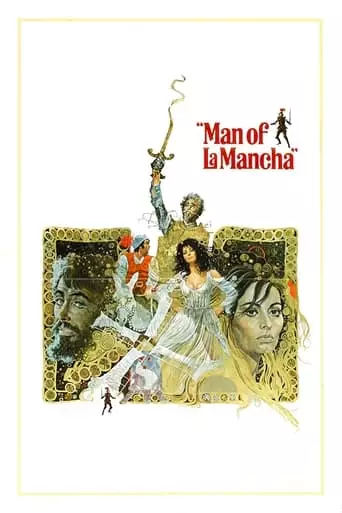
Man of La Mancha (1972) Watch Online Free
In the sixteenth century, Miguel de Cervantes, poet, playwright, and part-time actor, has been arrested, together with his manservant, by the Spanish Inquisition. They are accused of presenting an entertainment offensive to the Inquisition. Inside the huge dungeon into which they have been cast, the other prisoners gang up on Cervantes and his manservant, and begin a mock trial, with the intention of stealing or burning his possessions. Cervantes wishes to desperately save a manuscript he carries with him and stages, with costumes, makeup, and the participation of the other prisoners, an unusual defense–the story of Don Quixote.
Man of La Mancha is a musical drama that intertwines the life of Miguel de Cervantes with his creation, Don Quixote. The film presents a meta-narrative where Cervantes, imprisoned in 16th-century Spain, seeks to protect his manuscript from fellow inmates by staging a play about his novel.
Plot Summary
In a Spanish prison, Cervantes and his servant, Sancho Panza, are thrown into a dungeon with other prisoners. To defend his manuscript of Don Quixote, Cervantes proposes a theatrical performance, casting the inmates in various roles. He assumes the persona of Don Quixote, a delusional knight-errant, and narrates his adventures alongside his squire, Sancho. The narrative blurs the lines between reality and imagination, exploring themes of idealism and human nature.
Analysis
Directed by Arthur Hiller, Man of La Mancha adapts the Broadway musical for the screen. The film’s structure, set within a prison, reflects the play’s stage origins, creating a confined, theatrical atmosphere. While the performances, particularly by Peter O’Toole as Cervantes/Don Quixote and Sophia Loren as Aldonza/Dulcinea, are commendable, the film’s pacing and adaptation choices received mixed reviews. Critics noted that the transition from stage to screen posed challenges, with some elements not translating effectively to the cinematic medium.
Idealism vs. Reality
The film delves into the conflict between lofty ideals and harsh realities. Don Quixote’s unwavering belief in chivalry and honor contrasts sharply with the cynical world around him, highlighting the tension between dreams and disillusionment.
Imagination and Escapism
Man of La Mancha emphasizes the power of imagination as a means of coping with adversity. Cervantes’ creation of Don Quixote serves as an escape from the grim realities of prison life, illustrating the human need for fantasy and hope.
Human Nature and Redemption
Through its characters, the film explores themes of human nature, including the capacity for cruelty and kindness. The transformation of Aldonza into Dulcinea symbolizes the potential for redemption and the impact of seeing the good in others.
Upon its release, Man of La Mancha received mixed reviews. While some praised the performances and the film’s faithfulness to the stage production, others criticized its pacing and adaptation choices. Over time, it has gained a cult following, appreciated for its thematic depth and the performances of its leads.
Peter O’Toole delivers a nuanced portrayal of Cervantes and Don Quixote, capturing the character’s idealism and madness. Sophia Loren’s performance as Aldonza/Dulcinea adds depth, showcasing her versatility and emotional range.
The film brings the acclaimed Broadway musical to the screen, featuring memorable songs like The Impossible Dream. The music enhances the narrative, adding an emotional layer to the storytelling.
Man of La Mancha explores profound themes such as the conflict between idealism and reality, the power of imagination, and the potential for human redemption. These themes resonate with audiences, prompting reflection on personal values and societal norms.
Arthur Hiller’s direction creates a unique cinematic experience, blending the confines of a prison setting with the expansive adventures of Don Quixote. This juxtaposition adds a surreal quality to the film, enhancing its artistic appeal.
The film offers insight into the adaptation of stage productions to film, providing a case study in translating theatrical works to the screen. This aspect is particularly interesting for those interested in film studies and adaptation processes.
The film’s cinematography captures the stark beauty of the Spanish landscape, juxtaposed with the gritty realism of the prison setting. This contrast visually underscores the film’s themes of idealism versus reality.
Set in 16th-century Spain, the film provides a historical backdrop that enriches the narrative. It offers a glimpse into the era’s social and political climate, adding depth to the characters’ motivations and actions.
Watching Man of La Mancha may evoke a range of emotions, from inspiration to introspection. The film’s exploration of idealism and human nature prompts viewers to reflect on their own values and perceptions. The performances and music leave a lasting impression, making it a memorable cinematic experienc
